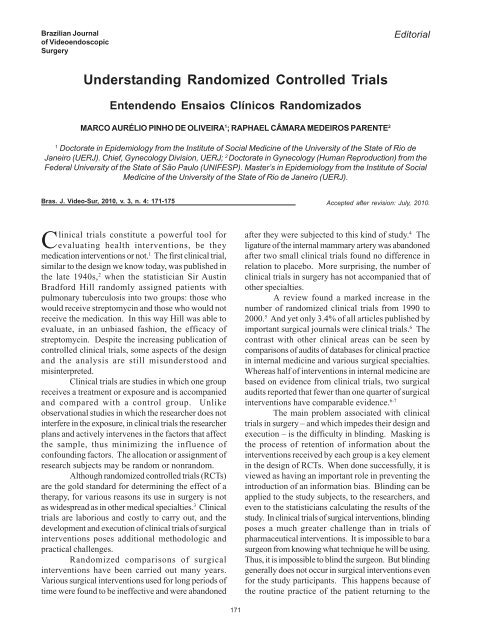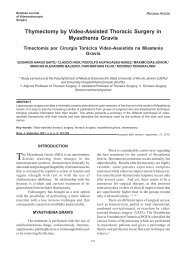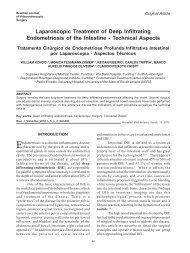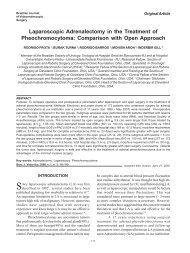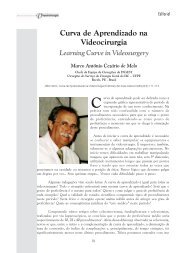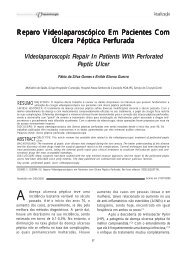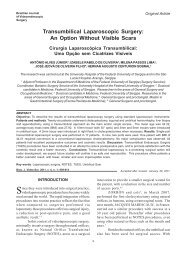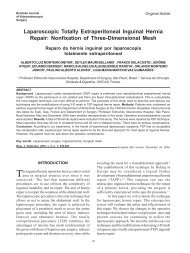Understanding Randomized Controlled Trials - Sobracil
Understanding Randomized Controlled Trials - Sobracil
Understanding Randomized Controlled Trials - Sobracil
Create successful ePaper yourself
Turn your PDF publications into a flip-book with our unique Google optimized e-Paper software.
Vol. Brazilian 3, Nº 4Journal<br />
of Videoendoscopic<br />
Surgery<br />
Editorial<br />
<strong>Understanding</strong> <strong>Randomized</strong> <strong>Controlled</strong> <strong>Trials</strong> 171<br />
<strong>Understanding</strong> <strong>Randomized</strong> <strong>Controlled</strong> <strong>Trials</strong><br />
Entendendo Ensaios Clínicos Randomizados<br />
MARCO AURÉLIO PINHO DE OLIVEIRA 1 ; RAPHAEL CÂMARA MEDEIROS PARENTE 2<br />
1<br />
Doctorate in Epidemiology from the Institute of Social Medicine of the University of the State of Rio de<br />
Janeiro (UERJ). Chief, Gynecology Division, UERJ; 2 Doctorate in Gynecology (Human Reproduction) from the<br />
Federal University of the State of São Paulo (UNIFESP). Master’s in Epidemiology from the Institute of Social<br />
Medicine of the University of the State of Rio de Janeiro (UERJ).<br />
Bras. J. Video-Sur, 2010, v. 3, n. 4: 171-175<br />
Accepted after revision: July, 2010.<br />
Clinical trials constitute a powerful tool for<br />
evaluating health interventions, be they<br />
medication interventions or not. 1 The first clinical trial,<br />
similar to the design we know today, was published in<br />
the late 1940s, 2 when the statistician Sir Austin<br />
Bradford Hill randomly assigned patients with<br />
pulmonary tuberculosis into two groups: those who<br />
would receive streptomycin and those who would not<br />
receive the medication. In this way Hill was able to<br />
evaluate, in an unbiased fashion, the efficacy of<br />
streptomycin. Despite the increasing publication of<br />
controlled clinical trials, some aspects of the design<br />
and the analysis are still misunderstood and<br />
misinterpreted.<br />
Clinical trials are studies in which one group<br />
receives a treatment or exposure and is accompanied<br />
and compared with a control group. Unlike<br />
observational studies in which the researcher does not<br />
interfere in the exposure, in clinical trials the researcher<br />
plans and actively intervenes in the factors that affect<br />
the sample, thus minimizing the influence of<br />
confounding factors. The allocation or assignment of<br />
research subjects may be random or nonrandom.<br />
Although randomized controlled trials (RCTs)<br />
are the gold standard for determining the effect of a<br />
therapy, for various reasons its use in surgery is not<br />
as widespread as in other medical specialties. 3 Clinical<br />
trials are laborious and costly to carry out, and the<br />
development and execution of clinical trials of surgical<br />
interventions poses additional methodologic and<br />
practical challenges.<br />
<strong>Randomized</strong> comparisons of surgical<br />
interventions have been carried out many years.<br />
Various surgical interventions used for long periods of<br />
time were found to be ineffective and were abandoned<br />
after they were subjected to this kind of study. 4 The<br />
ligature of the internal mammary artery was abandoned<br />
after two small clinical trials found no difference in<br />
relation to placebo. More surprising, the number of<br />
clinical trials in surgery has not accompanied that of<br />
other specialties.<br />
A review found a marked increase in the<br />
number of randomized clinical trials from 1990 to<br />
2000. 5 And yet only 3.4% of all articles published by<br />
important surgical journals were clinical trials. 6 The<br />
contrast with other clinical areas can be seen by<br />
comparisons of audits of databases for clinical practice<br />
in internal medicine and various surgical specialties.<br />
Whereas half of interventions in internal medicine are<br />
based on evidence from clinical trials, two surgical<br />
audits reported that fewer than one quarter of surgical<br />
interventions have comparable evidence. 6-7<br />
The main problem associated with clinical<br />
trials in surgery – and which impedes their design and<br />
execution – is the difficulty in blinding. Masking is<br />
the process of retention of information about the<br />
interventions received by each group is a key element<br />
in the design of RCTs. When done successfully, it is<br />
viewed as having an important role in preventing the<br />
introduction of an information bias. Blinding can be<br />
applied to the study subjects, to the researchers, and<br />
even to the statisticians calculating the results of the<br />
study. In clinical trials of surgical interventions, blinding<br />
poses a much greater challenge than in trials of<br />
pharmaceutical interventions. It is impossible to bar a<br />
surgeon from knowing what technique he will be using.<br />
Thus, it is impossible to blind the surgeon. But blinding<br />
generally does not occur in surgical interventions even<br />
for the study participants. This happens because of<br />
the routine practice of the patient returning to the<br />
171
172 Oliveira et al.<br />
Bras. J. Video-Sur., October / December 2010<br />
surgeon who operated post-operatively for follow-up.<br />
The blinding of patients is feasible when the same<br />
surgical access is used for different surgical<br />
procedures. Blinding patients is more difficult when<br />
the surgical approaches are different, for example,<br />
laparotomy compared with laparoscopy, and it is<br />
virtually impossible when one compares surgery with<br />
medical management. Although surgery as a placebo<br />
is theoretically possible – and there are examples in<br />
the literature 8 – the conception of such studies is often<br />
impeded by ethical considerations.<br />
Carefully conducted randomized clinical trials<br />
are the gold standard among studies to guide our dayto-day<br />
clinical practice. In developing a RCT one<br />
seeks a study that is large enough that an important<br />
clinical effect can achieve statistical significance, but<br />
not so big that minor outcomes are significant.<br />
Moreover, when excessively large, RCTs can<br />
be prohibitively expensive. 9 The sample size for any<br />
study is calculated based on the number of type I and<br />
II errors that the researcher is willing to tolerate. A<br />
strength of RCTs is that random assignment minimizes<br />
the impact of confounding factors by distributing them<br />
equally among the groups. However, there are major<br />
drawbacks of a single large RCT.<br />
First, some RCTs are so methodologically<br />
rigorous that findings are only applicable to the<br />
population studied (problems of external validity or<br />
generalizability). In addition, patients participating in<br />
clinical trials may have a baseline risk for the outcome<br />
of interest that is much greater than the average of<br />
the patients of the population or the subjects may be<br />
from very different populations. For example, some<br />
studies that have investigated calcium intake for the<br />
prevention of pre-eclampsia have been carried out in<br />
countries with very different diets, which makes it<br />
difficult to extend conclusions to populations with other<br />
diets. This can limit the generalizability of findings.<br />
Another issue is that some clinical trials may not have<br />
a sufficient number of individuals in important<br />
subgroups.<br />
A final concern with randomized controlled<br />
trials is the issue of publication bias. Publication bias<br />
occurs when the findings of studies that report positive<br />
results (i.e, statistically significant) are more likely to<br />
be published than studies with negative results. The<br />
studies that report significant results may result in a<br />
greater number of publications and will also be<br />
published in journals of greater impact. In this way<br />
publication biases may affect meta-analysis since these<br />
are unable to consider trials with unfavorable findings<br />
that were never published.<br />
A randomized clinical trial is a prospective<br />
study of human subjects comparing the effect and value<br />
of an intervention versus a control. 10<br />
1. <strong>Randomized</strong> controlled trials should be<br />
considered when:<br />
a. There is uncertainty about the effect of an<br />
exposure or treatment;<br />
b. The exposure can be changed in the study.<br />
2. Potential limitations of randomized clinical<br />
trials include:<br />
a. Limited generalizability of the study<br />
population.<br />
b. Limited generalizability of the environment<br />
under study.<br />
c. <strong>Randomized</strong> clinical trials address a specific<br />
study question.<br />
3. The usual measures of the magnitude of<br />
effect in randomized clinical trials are relative risk and<br />
risk difference.<br />
In RCTs, a treatment or procedure may be<br />
compared to no treatment, treatment with a similar<br />
medication (e.g., same class of drugs in head-to-head<br />
trials), with a placebo, or a preexisting standard of<br />
care. 10 RCTs are conducted under controlled<br />
conditions to ensure that the study hypothesis is tested<br />
in a reproducible manner. RCT protocols often cannot<br />
be repeated in clinical practice. The highly specialized<br />
conditions in which in a randomized trial is conducted<br />
may result in conclusions that are internally valid, but<br />
which cannot be generalized to patients with the same<br />
disease outside the study. 10<br />
4. <strong>Randomized</strong> clinical trials are designed to<br />
definitively answer a specific question, focusing strictly<br />
on a research hypothesis, isolating the effect of one<br />
or a small number of therapies. <strong>Randomized</strong> clinical<br />
trials are not designed to evaluate the mechanisms by<br />
which a therapy can produce benefits or harm. They<br />
usually have narrow clinical applicability. The<br />
conclusions derived from RCTs are limited to the<br />
situations in which the exposure of interest can be<br />
modified in a study environment, for example, using<br />
medications or lifestyle changes. There are<br />
innumerable exposures that are extremely worthy of<br />
investigation, but which cannot be easily modified, such
Vol. 3, Nº 4<br />
<strong>Understanding</strong> <strong>Randomized</strong> <strong>Controlled</strong> <strong>Trials</strong> 173<br />
as genes, serum markers, socioeconomic conditions,<br />
etc.<br />
<strong>Randomized</strong> controlled trials are limited to<br />
specific clinical situations in which the exposure of<br />
interest can be easily modified. Nor can they be used<br />
in situations where exposure is known to be deleterious,<br />
because it is not ethical. For example, we cannot get<br />
someone to smoke in order to be compared with a<br />
group who do not smoke because we already know<br />
hazards of smoking.<br />
The investigation of new drugs by the<br />
pharmaceutical industry involves RCTs in different<br />
phases. They are carried out in basically four phases 10 :<br />
Phase I Studies<br />
The first step in developing a new drug is<br />
to understand whether the medication is well<br />
tolerated in a small number of people. Although<br />
not controlled clinical trials, these types of studies<br />
are referred to as Phase I studies. Participants in<br />
Phase I trials are either healthy adults or people<br />
with the specific disease that the drug is intended<br />
to treat. Occasionally, phase I studies cannot be<br />
performed in healthy adults because the drug has<br />
unacceptable adverse effects; this is the case with<br />
chemotherapeutic agents. Phase I trials seek to<br />
determine what maximum dose a drug can be<br />
administered before unacceptable toxicity occurs.<br />
These studies are begin with low doses in a limited<br />
number of people, with the dose increased<br />
gradually.<br />
Phase II Studies<br />
Phase II studies are designed to evaluate<br />
whether a drug has biological activity and to determine<br />
its safety and tolerability.<br />
Phase III / IV Studies<br />
Phase III studies are randomized clinical trials<br />
designed to assess the efficacy and safety of an<br />
intervention. The results of phase III studies are<br />
clinical endpoints such as death or tumor-free survival.<br />
Assessments of safety occur over a longer period than<br />
with phase II studies. Phase IV studies occur after<br />
regulatory approval and measure outcomes associated<br />
with a drug or intervention in routine clinical use in the<br />
general population.<br />
In the critical evaluation of a randomized<br />
clinical trial, we should ask several important questions,<br />
using some information already outlined above.<br />
The first question one should ask is “Are the<br />
patients selected for this study similar to patients that<br />
I treat?”<br />
The study should state clearly the inclusion<br />
and exclusion criteria (e.g. age, gender, prior illnesses,<br />
etc.) The conclusions of studies with very restrictive<br />
inclusion criteria are limited in terms of their<br />
generalizability (but are more specific).<br />
The study report should also mention how<br />
patients were selected from the general population.<br />
Several examples that might introduce biases: Were<br />
study enrollees all patients who presented to a tertiary<br />
hospital? Were they paid volunteers, and if so, were<br />
they patients drawn from a poor community near the<br />
hospital?<br />
Remember that we can only generalize to<br />
populations similar to the one in the study. It is up to<br />
the reader to decide whether differences between the<br />
population selected in the study and the population that<br />
interests them are important or not.<br />
Another key aspect is the clinical endpoint of<br />
interest. Many studies that are well structured<br />
methodologically, but evaluate variables that are not<br />
very useful clinically, or do not represent what they<br />
should. For example, in the treatment of endometriosis<br />
with an antiestrogen drug, the researcher finds only a<br />
statistically significant decrease in the American<br />
Fertility Society (AFS) score – which quantifies the<br />
extent of disease – and concludes that treatment is<br />
effective. But what endometriosis causes is basically<br />
infertility and pelvic pain, and the study in question did<br />
not assess what really matters (the clinical endpoint<br />
of interest), that is, if the patient’s pain improved or<br />
that she was able to get pregnant (the patient is not<br />
interested only in improving their AFS score). Another<br />
example would be a study to evaluate the effectiveness<br />
of a new chemotherapeutic agent, using as parameter<br />
only the reduction of tumor mass. The decrease of<br />
the tumor, however, may not correlate with survival,<br />
which is the outcome variable of interest for the<br />
patient.<br />
Another important issue is how individuals<br />
were allocated between the treatment group and<br />
control (or placebo) group. Studies that do not include<br />
a control or placebo group run the risk of showing<br />
that a treatment is effective when in fact it is not. A<br />
“placebo effect” can even produce improvement in<br />
symptoms in more than 50% of subjects. The placebo<br />
may even be more effective that the medication being<br />
studied! In other words, a patient’s improvement might
174 Oliveira et al.<br />
Bras. J. Video-Sur., October / December 2010<br />
occur not because of the treatment in question, but<br />
for other reasons: the natural history of the disease<br />
process, psychological aspects, etc. Sometimes, as<br />
for example, in the treatment of acute pelvic<br />
inflammatory disease, it is inappropriate to use of a<br />
placebo or have no treatment as the control. In these<br />
cases, the investigator can study a new drug using as<br />
a control group the treatment considered the standard<br />
of care.<br />
The next step is to verify how the<br />
randomization was done between the treatment and<br />
control groups. Randomization implies the chance<br />
assignment of patients so that each case has the same<br />
probability of being allocated to the intervention or<br />
control group. Non-randomized controlled studies are<br />
viewed as not have the same weight of scientific<br />
evidence as RCTs, because in most cases the<br />
intervention and control groups are not equivalent (i.e.,<br />
there is some bias). For example, in a study comparing<br />
Laparoscopic Burch Urethropexy and laparotomy, one<br />
could imagine that patients who were thinner and who<br />
had milder complaints of stress urinary incontinence<br />
might be selected for laparoscopy. If this selection<br />
bias were to occur, one could not compare these two<br />
distinct groups of patients, as it would put laparotomy<br />
at a disadvantage.<br />
Randomization ends up balancing known<br />
factors such as age, weight, stage of illness, as well<br />
as unknown (or immeasurable) factors (e.g., some<br />
genetic factor that cannot readily be detected that<br />
might influence the clinical outcome). True<br />
randomization should be done with random numbers<br />
generated by computer (there are also tables for this<br />
purpose) that are placed in numbered sealed envelopes<br />
that are opened immediately before treatment<br />
is administered. Inappropriate methods of<br />
randomization – sometimes called “quasirandomized”<br />
– include, for example, doing<br />
laparoscopic surgery on Mondays and Wednesdays<br />
and laparotomies on Tuesday and Thursday, or<br />
alternating laparoscopic surgery and laparotomy.<br />
These methods permit failures in the random<br />
assignment, even if unconsciously. For example, the<br />
surgeon (or the physician who referred the patient<br />
for surgery and is familiar with the design of the<br />
study) may consider a patient too obese for<br />
laparoscopy and subconsciously (or intentionally)<br />
postpone the surgery for a day, in order to coincide<br />
with day or turn for a laparotomy. Appropriate<br />
randomization will generally prevent this type of bias.<br />
Nevertheless, well executed randomization does not<br />
guarantee the equivalence of the groups, especially<br />
with small samples. Before analyzing the data, it is<br />
good idea to check if there really was a balanced<br />
assignment of patients, particularly regarding those<br />
characteristics which directly influence the outcome,<br />
such as disease stage, age, weight, etc.). Unbalanced<br />
groups may bias the results.<br />
One should also be concerned if the method<br />
used in measuring the clinical endpoint of interest<br />
was double-blinded. This means that neither the<br />
patient nor the professional making the assessment<br />
(for example, assessing the degree of<br />
postoperative pain in patients who may or may not<br />
have received the anesthetic marcaine in a surgical<br />
wound) may know whether the treatment was<br />
applied. The physician may unconsciously not fully<br />
appreciate the complaints of patients who belong<br />
to the group that received the investigational<br />
treatment, distorting the results. The patient may<br />
want to believe in a particular investigational or<br />
novel treatment and thus downplay or underreport<br />
symptoms. The double-blind method attempts to<br />
eliminate this potential type of subliminal bias. As<br />
with comparisons of clinical and surgical<br />
treatments, a double-blind approach is not always<br />
feasible. But you should not neglect to use a double<br />
blind approach whenever possible.<br />
Another important aspect is the duration of<br />
follow-up. First make sure that the duration of followup<br />
was adequate to assess the clinical outcome of<br />
interest. For example, in assessing the use of<br />
laparoscopic transection of the utero-sacral ligaments<br />
for relief of dysmenorrhea, the duration of follow-up<br />
should be at least one year, as the high number of<br />
relapses after this period is well established. Another<br />
relevant issue is whether the percentage of patients<br />
who were lost to follow-up was similar among the<br />
groups. Follow-up rates below 70% make it virtually<br />
impossible to analyze the data, as the abandonment<br />
may have occurred because of side effects or even<br />
deaths stemming from the treatment.<br />
The aforementioned errors are systematic, as<br />
opposed to random errors that can occur when<br />
working with any sample. The appropriate statistical<br />
analysis aims to identify whether the differences in<br />
results were obtained due to random errors or if a<br />
difference really does exist between the intervention<br />
and the control. The basic concepts of statistics will<br />
be addressed in the next issue of this journal.
Vol. 3, Nº 4<br />
<strong>Understanding</strong> <strong>Randomized</strong> <strong>Controlled</strong> <strong>Trials</strong> 175<br />
ADDITIONAL READING<br />
1. Medical Research Council. Streptomycin treatment of<br />
pulmonary tuberculosis. A Medical Research Council<br />
Investigation. BMJ.1948; 2:769-82.<br />
2. Coutinho ESF, da Cunha GM. Conceitos básicos de<br />
epidemiologia e estatística para a leitura de ensaios clínicos<br />
controlados. Rev Bras Psiquiatr. 2005; 27(2):146-51.<br />
3. Cook J. The challenges faced in the design, conduct and<br />
analysis of surgical RCTs. <strong>Trials</strong> 2009, 10:9.<br />
4. Ko CY, Sack J, Chang JT, Fink A: Reporting randomised,<br />
controlled trials: where quality of reporting may be improved.<br />
Dis Colon Rectum 2002, 45:443-447.<br />
5. Wente MN, Seiler CM, Uhl W, Büchler MW: Perspectives<br />
of evidence-based surgery. Dig Surg 2003, 20:263-269.<br />
6. Ellis J, Mulligan I, Rowe J, Sackett DL: Inpatient general<br />
medicine is evidence based. Lancet 1995, 364:407-410.<br />
7. Howes N, Chagla L, Thorpe M, McCulloch P: Surgical<br />
practice is evidence based. Br J Surg 1997, 84:1220-1223.<br />
8. Kenny SE, Shankar KR, Rintula R, Lamont GL, Lloyd DA:<br />
Evidence-based surgery: interventions in a regional paediatric<br />
surgical unit. Arch Dis Child 1997, 76:50-53.<br />
9. Scifres CM, Iams JD, Klebanoff M, Macones GA.<br />
Metaanalysis vs large clinical trials: which should guide our<br />
management? Am J Obstet Gynecol 2009; 200:484.e1-.e5.<br />
10. Kestenbaum B. Epidemiology and Biostatistics: An<br />
Introduction to Clinical Research, DOI 10.1007/978-0-387-<br />
88433-2_7, © Springer Science Business Media, LLC 2009.<br />
Correspondence Address:<br />
MARCO AURÉLIO PINHO DE OLIVEIRA<br />
Rua Coelho Neto, 55 / 201<br />
Tel.: (21) 9987-5843<br />
E-mail: maurelio@infolink.com.br<br />
Brazilian Journal of Videoendoscopic Surgery - v. 3 - n. 4 - Oct./Dec. 2010 - Subscription: + 55 21 3325-7724 - E-mail: revista@sobracil.org.br<br />
ISSN 1983-9901: (Press) ISSN 1983-991X: (on-line) - SOBRACIL - Press Graphic & Publishing Ltd. Rio de Janeiro, RJ-Brasil


